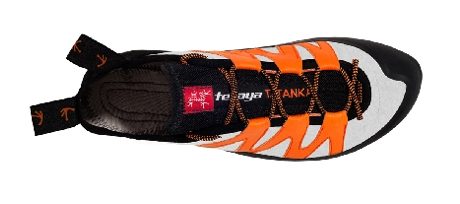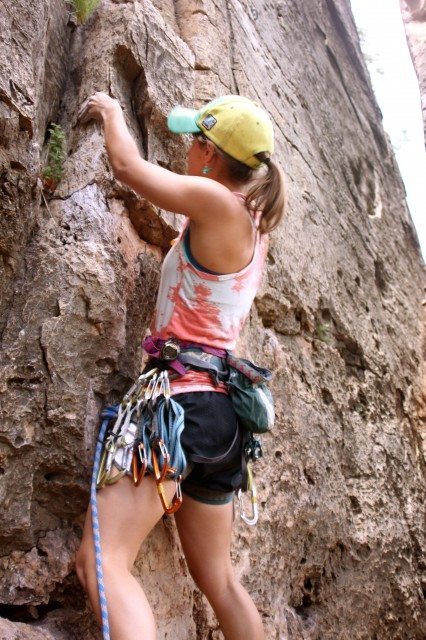
Tenaya Tatanka
Sizes: UK 3-13, including half sizes
Material: Microfiber
Lining: TXT treated cotton
Midsole: 2D PLT 10
Insole: TST multi-layer stretch tex
Sole: Vibram XS Grip 4mm
Weight: 340 grams
My Foot: Small, average shape, narrow heel, medium arch
Street Shoe Size: 5-5.5
Size Tested: US 4
Time Tested: About 3 weeks of climbing time
Locations Tested: Indoor gyms, Boulder Canyon, Shelf Road, CO
MSRP: $150
First Impressions
As soon as I pulled the Tenaya Tatankas out of the box and slipped them onto my feet, I noticed how light and comfortable they are. They’re an incredibly aggressive pair of shoes—Ramon Julian has taken them on multiple groundbreaking ascents—yet they felt almost weightless when I first put them on.
I grew up around climbers who believed the more painful the shoe, the better it would stick to rock. So I immediately questioned these shoes. Furthermore, few American climbers have heard of Tenaya shoes, let alone have worn them.
The Tatankas are noticeably different from other popular shoes such as the La Sportiva Solutions in a few key ways:
First, the shoe is very thin and flexible—it bends in your hands if you squeeze it tightly enough.
And the unique tongue is only fully attached on one side, and floats freely on the other. This makes it much easier to squeeze your foot inside while still ensuring a thoroughly snug fit.

Sizing
I generally wear a size 5 or so in climbing shoes, but since the Tenayas are not women-specific, so I got them in a US size 4. While the Tatankas are incredibly comfortable, they stretch only minimally, if at all.
Since they don’t need to be aggressively downsized in order to perform well, I would suggest buying a size that fits comfortably tight, not a size that seems like it will fit comfortably tight in a couple of weeks.
I wish I would have purchased the Tenayas in a half or full size larger for these reasons. The left shoe fits very well, but the right shoe is just a little too tight. I’ve found that performance is exactly the same in both shoes though, regardless of tightness.
And take note—since Tenaya shoes have a slightly different design than FiveTen, La Sportiva, and Evolv shoes, I recommend trying them on.
Fit
Once laced up, the Tatankas feel more like gloves than climbing shoes. They also feel different from other slipper-like shoes such as the Five Ten Moccasym or the La Sportiva Python.
The Tatankas are highly form-fitting, but slightly thicker and more supportive than the other slippers. And I’ve found the laces allow a snugger fit in the heel than shoes with Velcro straps or slipper designs.
Then there’s the toe and the sole. The Tatanka offers a middle ground between thin, sensitive shoes like the Anasazi and thicker, strong-edging shoes like the La Sportiva Katana or even the TC Pro. The Tatanka is much closer in stiffness to the Anasazi or Moccasym, yet they still have strong edges like the Katana or Miura. They’re almost as sensitive as the Miura.
I found this makes for an excellent balance, particularly on steep, difficult climbs. The sensitivity allowed me to feel holds with my feet, rather than physically look for them as I often do while wearing the TC Pro. And the stronger edges feel more secure on small, slippery holds than the Anasazi LV edges do.
I will say, however, that I would occasionally lose grip since the edge on the Tatanka is a bit softer than even the edge on the Anasazi LV. This was really only an issue on incredibly sloping holds, but still important to note.
The Tatanka is easily the most comfortable aggressive climbing shoe I have ever worn.

SXRD Dynamics
Tenaya uses a “moving tightening system” called SXRD Dynamics to increase precision and take full advantage of your foot’s natural properties.
While this system may well be crucial for the shoe’s performance, I noticed little difference between the Tatanka and other high-performance shoes besides increased comfort and decreased break-in time.
Otherwise, I found these shoes to perform just as well as other aggressive shoes on the market such as the La Sportiva Solution and Evolv Shaman.
In short, the somewhat mysterious SXRD Dynamics doesn’t perform any differently from the more popular hyper-downturned, extremely tight, aggressive shoe design. However, this “moving tightening system” does make the Tatanka extremely comfortable.
As far as I’m concerned, if SXRD Dynamics means you can get the same performance without all the horrible pain that comes from squeezing your feet into shoes three sizes too small, why on earth would you wear a different shoe?
